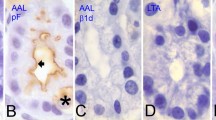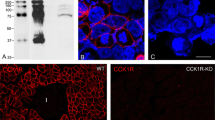Summary
Development and maturation of pepsinogen 1-producing cells were studied in the gastric fundic mucosa of the mouse by means of light- and electron-microscopic immunocytochemistry using rabbit anti-rat pepsinogen 1-serum. In the adult mouse, secretory granules in mucous neck cells, transitional mucous neck/chief cells and chief cells are immunolabeled. The numerical density of gold particles on zymogen granules is not significantly altered among different stages of maturation of chief cells. In addition, rough endoplasmic reticulum and Golgi complex of these cell types show a weak labeling. In mice from day 16 of gestation to postnatal day 14 mucous neck cells and chief cells cannot be distinguished, but only one type of pepsinogen 1-producing cell, called ‘primitive chief cell’, is identified in the fundic gland. The intensity of immunoreactivity of secretory granules in primitive chief cells is uniform within an individual cell but varies greatly among different cells. The majority of primitive chief cells contains weakly labeled granules regardless of the maturation stage of cells or of animals. On postnatal day 21, mucous neck, transitional and chief cells are distinguishable, and secretory granules in these cells are intensely immunolabeled as in the adult. These results suggest that pepsinogen 1-production rapidly increases with differentiation of mucouse neck and chief cells.
Similar content being viewed by others
References
Cornaggia M, Capella C, Riva C, Finzi G, Solcia E (1986) Electron immunocytochemical localization of pepsinogen I (PgI) in chief cells, mucous neck cells and transitional mucous neck/chief cells of the human fundic mucosa. Histochemistry 85:5–11
Cornaggia M, Riva C, Capella C, Solcia E, Samloff IM (1987) Subcellular localization of pepsinogen II in stomach and duodenum by the immunogold technique. Gastroenterology 92:585–593
Furihata C (1977) Differentiation and maturation of pepsinogen producing cells in the stomach glandular mucosa. Metabolism 14:893–900 (in Japanese)
Furihata C, Iwasaki Y, Sugimura T, Tatematsu M, Takahashi M (1973) Differentiation of pepsinogen-producing cells in the fundic and pyloric mucosa of developing rats. Cell Differ 2:179–189
Furihata C, Saito D, Fujiki H, Kanai Y, Matsushima T, Sugimura T (1980) Purification and characterization of pepsinogens and a unique pepsin from rat stomach. Eur J Biochem 105:43–50
Graham RC, Karnovsky MJ (1966) The early stages of absorption of injected horseradish peroxidase in the proximal tubules of mouse kidney: Ultrastructural cytochemistry by a new technique. J Histochem Cytochem 14:291–302
Hattori T, Fujita S (1976) Tritiated thymidine autoradiographic study on cellular migration in the gastric gland of the golden hamster. Cell Tissue Res 172:171–184
Hersey SJ (1987) Pepsinogen secretion. In: Johnson LR (ed) Physiology of the gastrointestinal tract. 2nd ed. Raven Press, New York, pp 947–957
Kantani-Matsumoto A, Kataoka K (1989) A carbohydrate histochemical study on surface mucous cells, mucous neck cells and chief cells in the gastric mucosa of developing mice. Arch Histol Cytol 52:37–50
Kataoka K (1969) Electron microscopic observations on a new cell type in the fundus mucosa of the mouse stomach. Z Zellforsch 100:93–100
Kataoka K (1970) Electron microscopic observations on cell proliferation and differentiation in the gastric mucosa of the mouse. Arch Histol Jpn 32:251–273
Kataoka K, Kantani-Matsumoto A (1989) Binding of Griffonia simplicifolia lectin II (GS II) in the mucous neck cell-chief cell series in the mouse gastric mucosa. J Electron Microsc 38:274
Kataoka K, Sakano Y (1984) Panoramic observation of the mouse gastric mucosa by superwide-field electron microscopy. Arch Histol Jpn 47:209–221
Kataoka K, Sakano Y, Miura J (1984) Histogenesis of the mouse gastric mucosa, with special reference to type and distribution of proliferative cells. Arch Histol Jpn 47:459–474
Kataoka K, Takeoka Y, Maesako J (1986) Electron microscopic observations on immature chief and parietal cells in the mouse gastric mucosa. Arch Histol Jpn 49: 321–331
Samloff IM (1971) Cellular localization of group I pepsinogens in human gastric mucosa by immunofluorescence. Gastroenterology 61:185–188
Samloff M, Liebman WM (1973) Cellular localization of the group II pepsinogens in human stomach and duodenum by immunofluorescence. Gastroenterology 65:36–42
Suzuki S, Furihata C, Tsuyama S, Murata F (1983) Immunocytochemical localization of pepsinogen in rat stomach. Histochemistry 79:167–176
Tamura S, Fujita H (1983) Fine structural aspects on the renewal and development of surface mucous cells and glandular cells of the gastric body of the adult golden hamster. Arch Histol Jpn 46:501–521
Theiler K (1972) The house mouse. Development and normal stages from fertilization to 4 weeks of age. Springer, Berlin London Heidelberg New York
Yasuda K, Suzuki T, Takano K (1966) Localization of pepsin in the stomach, revealed by fluorescent antibody technique. Okajima Fol Anat Jpn 42:355–367
Author information
Authors and Affiliations
Rights and permissions
About this article
Cite this article
Kataoka, K., Takeoka, Y. & Furihata, C. Immunocytochemical study of pepsinogen 1-producing cells in the fundic mucosa of the stomach in developing mice. Cell Tissue Res 261, 211–217 (1990). https://doi.org/10.1007/BF00318662
Accepted:
Issue Date:
DOI: https://doi.org/10.1007/BF00318662




